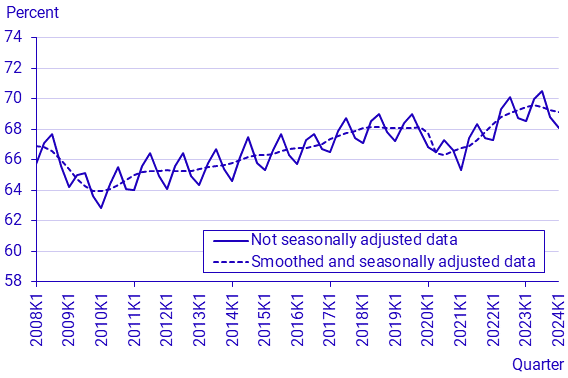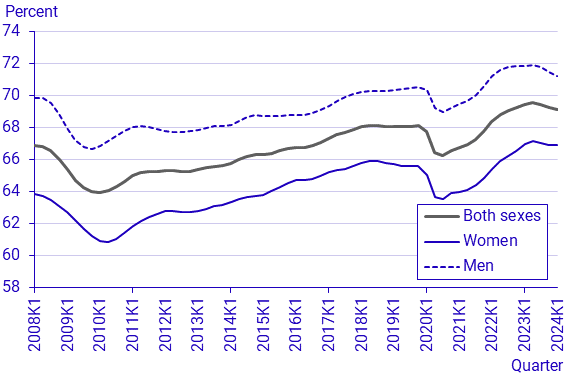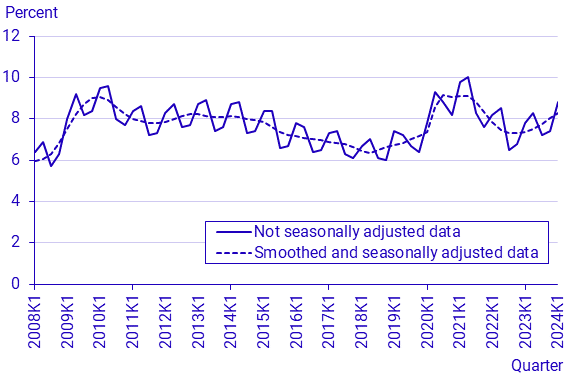Labour Force Survey (LFS), first quarter 2024
Weaker labour market for young people in the first quarter
Statistical news from Statistics Sweden 2024-05-07 8.00
In the first quarter of 2024, the number of employed people amounted to 5 168 000, not seasonally adjusted. There were 583 000 temporary employees, a decrease of 82 000. The average number of hours worked per week amounted to 163.3 million hours, a decrease of 4.0 million hours. There were 497 000 unemployed people, which is an increase of 56 000 people. This corresponds to an unemployment rate of 8.8 percent, an increase of 1.0 percentage points. Seasonally adjusted and smoothed data shows an increase in both the number and share of unemployed. The seasonally adjusted and smoothed unemployment rate amounted to 8.3 percent.
Due to a higher recommended retirement age from 2023, the reporting of the subgroup 20–64 years has been changed to 20–65 years.
–We can see a weaker development in the labour market, especially for young people. Employment is declining at the same time as the unemployment rate of young people is increasing, says Åsa Zakrisson, statistician at the Labour Force Surveys at SCB.
The labour force
The number of people in the labour force aged 15-74 years amounted to 5 665 000 during the first quarter of 2024, not seasonally adjusted. The number of women in the labour force amounted to 2 692 000 and the number of men was 2 972 000. The relative labour force participation rate amounted to 74.6 percent. Among women, the labour force participation rate was 72.1 percent and the labour force participation rate among men was 77.0 percent.
Seasonally adjusted and smoothed, the number of people in the labour force during the first quarter of 2024 amounted to 5 722 000, which corresponds to 75.4 percent of the population.
Employment
In the first quarter of 2024, there were 5 168 000 people aged 15–74 in employment, not seasonally adjusted, which corresponds to an employment rate of 68.1 percent. Among women, the number of employed was 2 461 000 and the number of men was 2 706 000. The employment rate for women was 66.0 percent and among men it was 70.1 percent. There were 469 000 young people aged 15–24 years in employment, a decrease of 20 000. The employment rate for people aged 15-24 was 39.2 percent, a decrease of 2.1 percentage points.
For people aged 15–74, seasonally adjusted and smoothed data shows a decrease in the number and share of employed people compared to adjacent quarters. Seasonally adjusted and smoothed, the number of employed people during the first quarter of 2024 amounted to 5 249 000. This corresponds to an employment rate of 69.1 percent. For people aged 15–24, seasonally adjusted and smoothed data shows a decrease in the number and the share of employed people compared to adjacent quarters. The number of employed young people amounted to 516 000, corresponding to an employment rate of 43.1. percent.
Employees
In the first quarter of 2024, there were 4 659 000 employees, not seasonally adjusted. Among those, 2 306 000 were women and 2 353 000 were men. There were 4 076 000 permanent employees, an increase of 67 000. Among permanent employees, the number of women was 1 982 000 and the number of men increased by 36 000 to 2 095 000. There were 583 000 temporary employees, a decrease of 82 000. Among them 325 000 were women, a decrease of 39 000, and 258 000 men, a decrease of 43 000.
Seasonally adjusted and smoothed, the number of employees amounted to 4 734 000. Among employees, 4 082 000 had a permanent employment and 652 000 a temporary employment. The number of permanent employees increased and the number of temporary employees decreased compared to adjacent quarters.
Hours worked
The average number of hours worked per week in the first quarter of 2024 amounted to 163.3 million hours, not seasonally adjusted. This is a decrease of 4.0 million hours. According to seasonally adjusted and smoothed data, the number of hours worked averaged to 158.1 million per week. This is an increase compared to adjacent quarter.
The majority of employed people have an agreed working time of 35 hours or more per week, that is, full-time work. In the first quarter of 2024, 4 061 000 people worked full time. Among them 1 794 000 were women and 2 267 000 were men. In total, 285 000 people worked short part-time (1–19 hours), and the number of people who worked long part time (20-34 hours) amounted to 603 000 people.
The average actual hours worked among employed people aged 15–74 years amounted to 31.7 hours per week in the first quarter of 2024. Women worked 29.5 hours per week and men 33.6 hours per week.
Underemployment
Among employed people aged 15–74, 349 000 were underemployed in the first quarter of 2024. The number of underemployed women amounted to 163 000 and the number of men was 187 000. Underemployed people accounted for 6.8 percent of employed people.
Unemployment
In the first quarter of 2024, there were 497 000 unemployed people aged 15–74, not seasonally adjusted. This is an increase of 56 000 people compared to the corresponding quarter previous year. The unemployment rate amounted to 8.8 percent, an increase of 1.0 percentage points. There were 231 000 unemployed women and 266 000 unemployed men, an increase of 37 000. The unemployment rate for women was 8.6 percent and the male unemployment rate was 8.9 percent, an increase of 1.2 percentage points.
For people aged 15–74, seasonally adjusted and smoothed data shows an increase in the number and share of unemployed people compared to adjacent quarters. The number of unemployed amounted to 473 000 in the first quarter of 2024, which corresponds to an unemployment rate of 8.3 percent.
There were 147 000 long-term unemployed people (unemployed for at least 27 weeks) aged 15–74 years in the first quarter of 2024, not seasonally adjusted. Among long-term unemployed people, the number of women was 70 000, an increase of 16 000, and the number of men amounted to 77 000.
There were 173 000 unemployed young people aged 15–24, not seasonally adjusted. This corresponds to an unemployment rate of 26.9 percent, an increase of 3.1 percentage points. Among unemployed young people, 121 000 people were full-time students. For people aged 15–24, seasonally adjusted and smoothed data shows an increase in the number and the share of unemployed people compared to adjacent quarters. The number of unemployed young people amounted to 163 000, corresponding to an unemployment rate of 24.0. percent.
Not in the labour force
The group 'not in the labour force' includes people who are not classified as employed nor as unemployed. In the first quarter of 2024, there were 1 929 000 people not in the labour force. The number of women not in the labour force was 1 040 000 and the number of men was 889 000.
Among people not in the labour force, 837 000 were retired, 646 000 were full-time students and 301 000 people reported that they were on long-term sick leave.
Latent job seekers
There were 264 000 latent job seekers aged 15–74 years in the first quarter of 2024. Among them, 126 000 were women and 139 000 were men. Among young people aged 15–24, the number of latent job seekers was 122 000.
Unused labour supply
Unemployed people, underemployed people and latent job seekers together comprise the unused labour supply. In the first quarter of 2024, the unused labour supply averaged 23.5 million hours per week, an increase of 2.5 million hours compared to the corresponding quarter in 2023. The unused labour supply corresponds to 588 000 full-time employments with 40-hour work weeks.
Labour market for persons aged 20–65 years
The population presented by the LFS is comprised of people aged 15–74 years. However, labour market participation among younger and older in this age group is considerably lower for natural reasons, as this group contains large shares of students and retired people. To better approach what can be seen as the core of the actively working population, the situation of the age group 20–65 years is described in the following section.
The relative labour force participation rate among people aged 20–65 years amounted to 87.2 percent in the first quarter of 2024, not seasonally adjusted. For women, the relative workforce participation rate was 84.5 percent, and for men it was 89.7 percent. Seasonally adjusted and smoothed data shows a participation rate of 87.9 percent.
In the first quarter of 2024, the share of employed people aged 20–65 was 80.7 percent, not seasonally adjusted. For women, the corresponding figure was 78.5, and for men it was 82.8 percent. Compared to adjacent quarters, seasonally adjusted and smoothed data shows a decrease in the employment rate, which amounted to 81.7 percent.
According to not seasonally adjusted data, the unemployment rate in the age group 20–65 amounted to 7.5 percent in the first quarter of 2024, an increase of 0.9 percentage points. The unemployment rate among women was 7.1 percent and for men it was 7.8 percent, an increase by 1.2 percentage points. According to seasonally adjusted and smoothed data, the unemployment rate was 7.0 percent which was an increase compared to adjacent quarters.
Swedish born and foreign born persons aged 20–65 years
The relative labour force participation rate among Swedish born people, aged 20–65 years was 87.4 percent in the first quarter of 2024, not seasonally adjusted. Among Swedish born women it was 85.8 percent, and among Swedish born men it was 89.0 percent. Among foreign born people aged 20–65 years, the relative labour force participation rate was 86.6 percent. The corresponding figure among foreign born women was 81.1 percent and 91.8 percent among foreign born men. According to seasonally adjusted and smoothed data, the labour force participation rate was 88.1 percent among Swedish born people and 87.2 percent among foreign born people. There was an increase in the labour force participation rate among foreign born people compared to adjacent quarters.
In the first quarter of 2024, the share of employed Swedish born people aged 20–65 was 83.5 percent, not seasonally adjusted. Among Swedish born women, the employment rate was 82.3 percent and among Swedish born men the employment rate was 84.7 percent. Among foreign born people, the employment rate was 72.9 percent. Among foreign born women, the employment rate was 68.2 percent and among foreign born men it was 77.5 percent. Seasonally adjusted and smoothed data shows that the employment rate was 84.5 percent among Swedish born people and 74.0 percent among foreign born people. There was a decrease among foreign born people compared to adjacent quarters.
The relative unemployment rate among Swedish born people aged 20–65 years was 4.4 percent in the first quarter of 2024, not seasonally adjusted. This was an increase of 0.6 percentage points compared to the corresponding quarter in 2023. Among Swedish born women, the unemployment rate was 4.0 percent, and the male unemployment rate was 4.8 percent, an increase of 0.8 percentage points. The unemployment rate among foreign born people was 15.8 percent. Among foreign born women it was 16.0 percent and among foreign born men the corresponding number was 15.7 percent. Seasonally adjusted and smoothed data shows that the unemployment rate was 4.1 percent among Swedish born people and 15.1 percent among foreign born people. This was an increase for both Swedish born and foreign born people compared to adjacent quarters.




Source: Statistics Sweden
Definitions and explanations
Since the LFS is a sample survey, the results are subject to some uncertainty. The LFS basic tables contain uncertainty figures and refer to non-seasonally adjusted data.
Seasonally adjusted and smoothed data (trend values): data in which normal seasonal variations have been removed, then smoothed to reduce sampling error and short-term variations. Seasonally adjusted and smoothed data may be revised following new monthly outcomes and usually does not coincide with non-seasonally adjusted data. Seasonally adjusted and smoothed data is not to be compared with non-seasonally adjusted data.
More detailed results are available in the form of figures and tables on employed persons, hours worked, unemployed persons and more, on Statistics Sweden’s website.
Next publishing will be
2024-05-22, at 08:00.
Feel free to use the facts from this statistical news but remember to state Source: Statistics Sweden.
